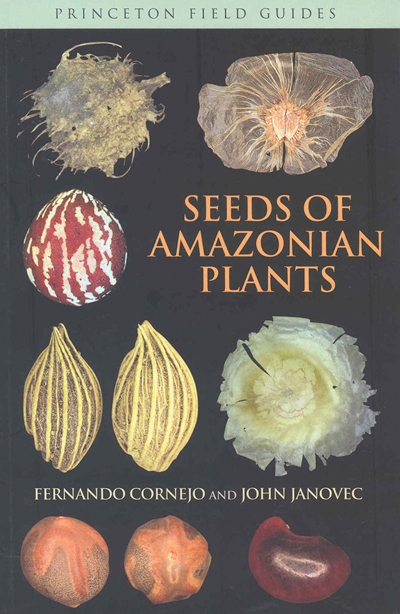
In the highly diverse flora of the Amazon, proper identification of seeds and fruits may require additional plant material, such as leaves, stems and preferably also flowers. This is, however, often not possible: tropical trees may be difficult to climb up and normally no flowers are available during fruiting. Sometimes fruits and seeds have to be identified without even knowing the source plant. This field guide by Cornejo and Janovec has accepted the challenge to produce a key for the identification of the most common Amazonian plants to genus level by easily recognizable characteristics of seeds. The book dedicates 148 of a total of 186 pages to colour photographs of diaspores from 512 genera in 132 families and includes for each genus a few lines of description, geographical distribution and its use in the Amazon. The last ten pages contain a glossary of botanical terms and two pages of illustrations.
Having the book in your hands, you find yourself continually leafing through it to appreciate the astonishing variety of seed shapes and colours. The (mostly) good quality photographs were taken from the most common species of the seed collection of the Cocha Cashu Biological Station in Manu National Park, located in Madre de Dios, Peru. Despite the high diversity in the large Amazonian region, the selection represents approximately 39 % of the genera and 68 % of the families of the flora (Forzza et al., 2010). The unique contribution of the book lies in the ease with which the key, based on a few, easily recognizable characters, can be applied. Wind dispersed seeds are treated separately and classified according to the arrangement of the hairs and wings (one side, both sides, circular, or number of wings). The other seeds are distinguished by size (tiny, small, medium or large), form (round, elongate, flat or irregular), colour (generally grey or black, brown or reddish, whitish or yellowish), and surface (irregular or striate, smooth and opaque, smooth and glossy). After each combination a list of possible genus names is given with the page number of the corresponding image. Testing the key, I was surprised to see that, with the combination of the given characteristics, the majority (308) of the genera can be identified by comparing up to five images only. This number increases to 22 or 32 images for only three possible combinations of characteristics. I looked up an arbitrary sample of 50 common tree seeds of our reference collection from the central Amazon near Manaus, Brazil (approx. 1000 miles from Madre de Dios): in an average time of 5 minutes per species I could identify 70 % to genus and 90 % to family – only 10 % were not listed in the book. Thus the field guide is an incredible contribution for anyone who wishes to give a genus name to a seed of an Amazonian plant from the non-flooded forest.
Unfortunately the book has a long list of shortcomings. Without trying to reduce its valuable contribution, some should be mentioned. It lacks a genus index. The identification key has a few mistakes in the indicated page number for the genus: if you know the family, the corresponding picture can be found easily; if not, you have to look up the family in another book. Even more puzzling, you have to use one book that uses the Cronquist system to get to the seed images in this guide and another one to look up the actual family name based on the Angiosperm Phylogeny Group III.
The key is based on a combination of Roman numbers and Arabic letters. The same alphabetical sequence of letters is used for all seed-size classes in spite of a different number of subdivisions. Thus the same letters can represent different characteristics: e.g., for tiny seeds the letter ‘j’ means round, grey or black coloured; however, for small seeds the same letter means elongated and blue coloured. The key uses cm, but the scales on the images seem to be in mm with two decimal places, giving an exaggerated precision.
The photographs were taken from dry seeds, which may sometimes limit the use in the field with fresh material. It is, however, a great pity that the seed images have no species names. More information would also be helpful for some images where the seed is enclosed in fruit parts: the fruit or even the fruit with persistent flower parts are shown, rather than the seed. Even so, the shortcomings do not limit the use and beauty of this field guide.
The field guide Seeds of Amazonian plants is a breakthrough for anybody who needs to identify to genus level the seeds (sensu latu) of hundreds of common plants in the Amazon region. It will be of enormous use for many people working on conservation, natural regeneration, seed dispersal or propagation of native species, such as botanists, ecologists, zoologists and foresters. There is no other book available with this purpose, and the stunning full-colour photographs will be appreciated by any nature enthusiast.
LITERATURE CITED
- Forzza RC, et al. 2010 Catálogo de Plantas e Fungos do Brasil (2 volumes). Rio de Janeiro: Andrea Jakobsson Estúdio/Instituto de Pesquisas Jardim Botânico do Rio de Janeiro. Both volumes are free for download at: http:floradobrasil.jbrj.gov.br/2010/download?vol1.pdf. and http:floradobrasil.jbrj.gov.br/2010/download?vol2.pdf. (accessed 13 July, 2011) [Google Scholar]


